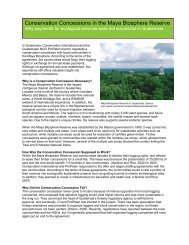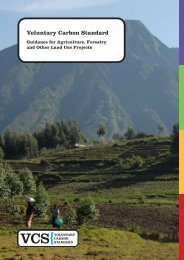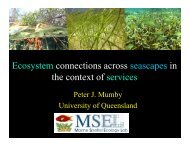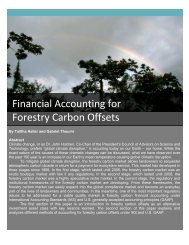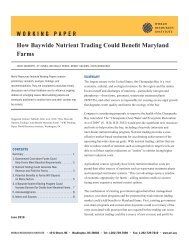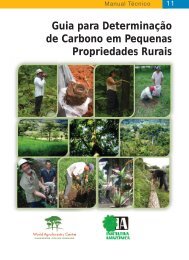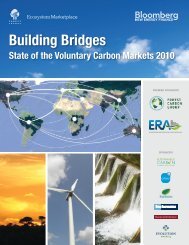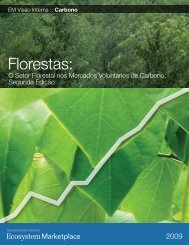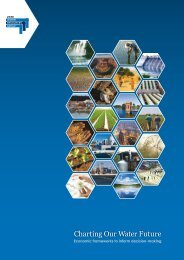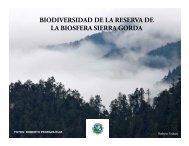Design of US Habitat Banking Systems to Support the Conservation ...
Design of US Habitat Banking Systems to Support the Conservation ...
Design of US Habitat Banking Systems to Support the Conservation ...
You also want an ePaper? Increase the reach of your titles
YUMPU automatically turns print PDFs into web optimized ePapers that Google loves.
A DETAILED LOOK AT WETLAND AND CONSERVATION BANKINGhave been met. 200 Different management requirementsgenerally apply during each <strong>of</strong> <strong>the</strong>se distinct phases.Requirements for each phase should be spelled out in<strong>the</strong> banking instrument.Before a wetland mitigation bank can sell credits, <strong>the</strong>bank site must be secured. 201 In practice <strong>the</strong> Corpsrequires most, if not all, banks <strong>to</strong> be protected inperpetuity. 202 The exceptions are in Louisiana, where<strong>the</strong> life <strong>of</strong> marsh mitigation banks is only 20 years and50 years for forested wetland mitigation banks 203 andbanks sited on public lands. In 2002, ELI reported that<strong>of</strong> <strong>the</strong> 54 banks on public lands nationwide, fewer thanhalf <strong>of</strong> <strong>the</strong> authorizing instruments specify <strong>the</strong> legalassurances for land protection. 204Existing federal guidance states that wetland mitigationbanks should be protected using “appropriatereal estate arrangements.” 205 Although <strong>the</strong> agencies donot require a specific type <strong>of</strong> protection mechanism,enforcement problems encountered with deed restrictionsled <strong>the</strong> Corps <strong>to</strong> suggest in 2002 that conservationeasements are preferable <strong>to</strong> deed restrictions. 206Regardless, <strong>the</strong> instrument used should restrict usesthat might “jeopardize <strong>the</strong> purpose <strong>of</strong> <strong>the</strong> bank.” 207Financing <strong>of</strong> bank management – remedial and longtermThe 1995 <strong>Banking</strong> Guidance states that <strong>the</strong> bank sponsoris responsible for establishing two types <strong>of</strong> funds<strong>to</strong> ensure <strong>the</strong> operation and long-term protection <strong>of</strong><strong>the</strong> bank: remedial funds and long-term managementfunds. 208 The banking instrument should identify <strong>the</strong>terms <strong>of</strong> both funds and <strong>the</strong> entity responsible for holding<strong>the</strong> funds and carrying out <strong>the</strong> required activities.200 <strong>Banking</strong> Guidance (1995), § II, E, 1.201 <strong>Banking</strong> Guidance (1995), § II, D, 6.202 Banks and Fees (2002), p. 80. Of <strong>the</strong> 219 instruments reviewed,76 percent indicated <strong>the</strong> mechanism that would be used <strong>to</strong> protect<strong>the</strong> land in perpetuity.203 La. Admin. Code tit. 43:I, §724. Banks and Fees (2002), p. 85.204 Banks and Fees (2002), p. 44.205 <strong>Banking</strong> Guidance (1995), § II, E, 2.206 RGL 02-2 (2002), § 3, g.207 <strong>Banking</strong> Guidance (1995), § II, E, 2.208 <strong>Banking</strong> Guidance (1995) § II, E, 2.Remedial funds are those set aside <strong>to</strong> “cover contingencyactions in <strong>the</strong> event <strong>of</strong> bank default orfailure.” 209 The amount <strong>of</strong> funds required should beadjusted <strong>to</strong> reflect <strong>the</strong> risk <strong>of</strong> <strong>the</strong> bank failing <strong>to</strong> meetits performance standards and <strong>the</strong> amount <strong>of</strong> creditsreleased before ecological performance standards havebeen met. Financial assurances for remedial actionsmay be phased-out or reduced as <strong>the</strong> bank’s performancestandards are met. 210 For example, <strong>the</strong> bankinginstrument for WetBank – Gunnison in Coloradoindicates that 33 percent <strong>of</strong> <strong>the</strong> performance bond willbe released upon establishment <strong>of</strong> wetland vegetation,33 percent upon establishment <strong>of</strong> woody riparian vegetation,and <strong>the</strong> final 34 percent upon attainment <strong>of</strong>noxious weed control. 211Long-term management funds are those designed <strong>to</strong>provide <strong>the</strong> long-term steward <strong>of</strong> <strong>the</strong> site – ei<strong>the</strong>r <strong>the</strong>bank’s sponsor or a third party <strong>to</strong> whom <strong>the</strong> real estateprotection instrument had been transferred – with <strong>the</strong>resources necessary <strong>to</strong> carry out <strong>the</strong> long-term managementresponsibilities spelled out in <strong>the</strong> bankinginstrument. The entity taking on <strong>the</strong> long-term stewardship<strong>of</strong> compensation sites should secure adequatefunding <strong>to</strong> provide for <strong>the</strong> long-term managementneeds <strong>of</strong> <strong>the</strong> sites. One California non-pr<strong>of</strong>it organizationthat specializes in <strong>the</strong> long-term management <strong>of</strong>wetland and habitat mitigation sites, <strong>the</strong> Center forNatural Lands Management, has developed a <strong>to</strong>ol forcalculating adequate long-term management financialneeds. The Property Analysis Record (PAR) is a computerizeddatabase methodology that estimates <strong>the</strong>costs <strong>of</strong> management activities and generates reports<strong>to</strong> substantiate long-term funding requirements,including endowments. 212The state wildlife action plans all provide detailedinformation on conservation actions for species <strong>of</strong>conservation concern. If <strong>the</strong>se actions are sufficientlywell-developed for wetland species, <strong>the</strong>y could be209 <strong>Banking</strong> Guidance (1995), § II, E, 5.210 Banks and Fees (2002), p. 67.211 Still Water - Ohio Creek, LLLP. <strong>Banking</strong> Instrument for <strong>the</strong>WetBank – Gunnison Wetland Mitigation Bank. <strong>Banking</strong> Instrument.Gunnison County, CO. 1999. p. 16.212 For more on PAR see: http://www.cnlm.org/cms/index.php?option=com_content&task=view&id=21&Itemid=155.<strong>Design</strong> <strong>of</strong> U.S. <strong>Habitat</strong> <strong>Banking</strong> <strong>Systems</strong> <strong>to</strong> <strong>Support</strong> <strong>the</strong> <strong>Conservation</strong> <strong>of</strong> Wildlife <strong>Habitat</strong> and At-Risk Species 49



